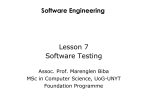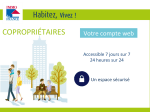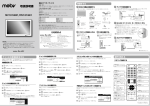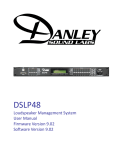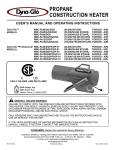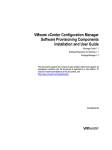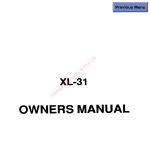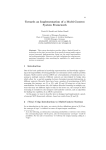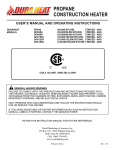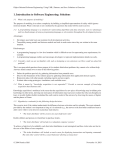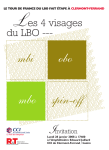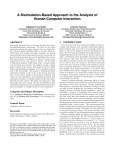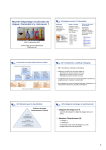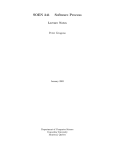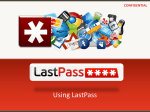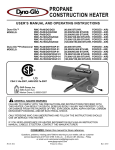Download BDSA.2013.TEST - ITU old blogs
Transcript
Analysis, Design, & So:ware Architecture (BDSA) Jakob E. Bardram QUALITY ASSURANCE & TESTING © Jakob E. Bardram This Lecture • Literature – [OOSE] ch. 11 – [SE9] ch. 8 (+24) • IntroducMon to So:ware TesMng • TesMng Terminology • TesMng AcMviMes –
–
–
–
Unit / Component TesMng IntegraMon TesMng System TesMng Client / Acceptance TesMng • Managing TesMng –
–
–
–
Test Cases Test Teams Test Driven Development DocumenMng TesMng © Jakob E. Bardram Program TesMng • TesMng is – intended to show that a program does what it is intended to do and to discover program defects before it is put into use. – the process of finding difference between the expected behavior specified by system models and the observed behavior of the implemented system – the aZempt to show that the implementaMon of the system is inconsistent with the system models • The goal of tesMng is to – design tests that exercise defects in the system – to reveal problems • TesMng is in contrast to all other system acMviMes – tesMng is aimed at breaking the system • HENCE : tesMng can reveal the presence of errors – NOT their absence! • TesMng is part of a more general verificaMon and validaMon process, which also includes staMc validaMon techniques. © Jakob E. Bardram 3 Famous Problems • F-16 : crossing equator using autopilot
– Result: plane flipped over
– Reason?
• Reuse of autopilot
software from a rocket
• NASA Mars Climate Orbiter destroyed due to incorrect
orbit insertion (September 23, 1999)"
– Reason: Unit conversion problem"
• The Therac-25 accidents (1985-1987), quite possibly the
most serious non-military computer-related failure ever in
terms of human life (at least five died)"
– Reason: Bad event handling in the GUI,"
© Jakob E. Bardram The Therac-‐25 • The Therac-25 was a medical
linear accelerator
• Linear accelerators create energy
beams to destroy tumors
• For shallow tissue penetration, electron beams are used
• To reach deeper tissue, the beam is converted into x-rays
• The Therac-25 had two main types of operation, a low
energy mode and a high energy mode:
– In low energy mode, an electronic beam of low radiation (200 rads)
is generated
– In high energy mode the machine generates 25000 rads with 25
million electron volts
• Therac-25 was developed by two companies, AECL from
Canada and CGR from France
– Newest version(reusing code from Therac-6 and Therac-20).
© Jakob E. Bardram A Therac-‐25 Accident • In 1986, a patient went into the clinic to receive his usual
low radiation treatment for his shoulder
• The technician typed „X“ (x-ray beam), realizing the error,
quickly changed „X" into „E" (electron beam), and hit
"enter“:
– X <Delete char> E <enter>!
– This input sequence in a short time frame (about 8 sec) was never
tested
• Therac-25 signaled "beam ready“ and it also showed the
technician that it was in low energy mode
• The technician typed „B" to deliver the beam to the patient
– The beam that actually came from the machine was a blast of 25
000 rads with 25 million electron volts, more than 125 times the
regular dose
– The machine responded with error message Malfunction 54 ,
which was not explained in the user manual. Machine showed
under dosage.
– Operator hit P to continue for more treatment. Again, the same
error message
• The patient felt sharp pains in his back, much different from
his usual treatment. He died 3 months later.
© Jakob E. Bardram Reasons for the Therac-‐25 Failure • Failure to properly reuse the old software from
Therac-6 and Therac-20 when using it for new
machine
• Cryptic warning messages
• End users did not understand the recurring
problem (5 patients died)
• Lack of communication between hospital and
manufacturer
• The manufacturer did not believe that the
machine could fail
• No proper hardware to catch safety glitches.
© Jakob E. Bardram TesMng Terminology © Jakob E. Bardram Terminology
• Failure: Any deviation of the observed behavior
from the specified behavior
• Erroneous state (error): The system is in a state
such that further processing by the system can
lead to a failure
• Fault: The mechanical or algorithmic cause of an
error ( bug )
• Validation: Activity of checking for deviations
between the observed behavior of a system and
its specification.
© Jakob E. Bardram What is this?
A failure?
An error?
A fault?
We need to describe specified
behavior first!
Specification: A track shall
support a moving train
Erroneous State ( Error )
Fault
Possible algorithmic fault: Compass shows wrong reading
Or: Wrong usage of compass
Another possible fault: Communication problems between teams
Mechanical Fault
F-‐16 Bug • Where is the failure?
• Where is the error?
• What is the fault?
– Bad use of implementation
inheritance
– A Plane is not a rocket.
Rocket Plane © Jakob E. Bardram Examples of Faults and Errors
• Faults in the Interface • Mechanical Faults
specification
(very hard to find)
– Mismatch between
what the client needs
and what the server
offers
– Mismatch between
requirements and
implementation
• Algorithmic Faults
– Missing initialization
– Incorrect branching
condition
– Missing test for null
– Operating temperature
outside of equipment
specification
• Errors
–
–
–
–
Wrong user input
Null reference errors
Concurrency errors
Exceptions.
How do we deal with Errors,
Failures and Faults?
Modular Redundancy
Declaring the
Bug as a
Feature
Patching
TesMng Another View on How to Deal with Faults • Fault avoidance
–
–
–
–
Use methodology to reduce complexity
Use configuration management to prevent inconsistency
Apply verification to prevent algorithmic faults
Use reviews to identify faults already in the design
• Fault detection
– Testing: Activity to provoke failures in a planned way
– Debugging: Find and remove the cause (fault) of an
observed failure
– Monitoring: Deliver information about state and behavior
=> Used during debugging
• Fault tolerance
– Exception handling
– Modular redundancy.
© Jakob E. Bardram Fault Handling Fault Avoidance Methodoloy Fault DetecMon ConfiguraMon Management Fault Tolerance Atomic TransacMons VerificaMon TesMng Unit TesMng IntegraMon TesMng Debugging System TesMng © Jakob E. Bardram Modular Redundancy ObservaMons • It is impossible to
completely test any
nontrivial module or system
– Practical limitations: Complete
testing is prohibitive in time
and cost
– Theoretical limitations: e.g.
Halting problem
Edsger W. Dijkstra (1930-2002) Testing can only show the
presence of bugs, not their
absence (Dijkstra).
• Testing is not for free
•
– Define your goals and
priorities
© Jakob E. Bardram - First Algol 60 Compiler
- 1968:
- T.H.E. - Go To considered Harmful, CACM
- Since 1970 Focus on Verification
and Foundations of Computer Science - 1972 A. M. Turing Award
TesMng takes creaMvity • To develop an effective test, one must have:
–
–
–
–
Detailed understanding of the system
Application and solution domain knowledge
Knowledge of the testing techniques
Skill to apply these techniques
• Testing is done best by independent testers
– We often develop a certain mental attitude that the
program behave in a certain way when in fact it does not
– Programmers often stick to the data set that makes the
program work
– A program often does not work when tried by somebody
else.
© Jakob E. Bardram Test Model
• The Test Model consolidates all test related
decisions and components into one package
(sometimes also test package or test
requirements)
• The test model contains tests, test driver, input
data, oracle and the test harness
– A test driver (the program executing the test)
– The input data needed for the tests
– The oracle comparing the expected output with the
actual test output obtained from the test
– The test harness
• A framework or software components that allow to run the
tests under varying conditions and monitor the behavior and
outputs of the system under test (SUT)
• Test harnesses are necessary for automated testing.
© Jakob E. Bardram Automated Testing
• There are two ways to generate the test model
– Manually: The developers set up the test data, run the test
and examine the results themselves. Success and/or failure
of the test is determined through observation by the
developers
– Automatically: Automated generation of test data and test
cases. Running the test is also done automatically, and
finally the comparison of the result with the oracel is also
done automatically
• Definition Automated Testing
– All the test cases are automatically executed with a test
harness
• Advantage of automated testing:
–
–
–
–
Less boring for the developer
Better test thoroughness
Reduces the cost of test execution
Indispensible for regression testing.
© Jakob E. Bardram Test Doubles • A test double is like a double in the movies („stunt double )
replacing the movie actor, whenever it becomes dangerous
• A test double is used if the collaborator in the system
model is awkward to work with
• There are 4 types of test doubles. All doubles try to make
the SUT believe it is talking with its real collaborators:
– Dummy object: Passed around but never actually used. Dummy
objects are usually used to fill parameter lists
– Fake object: A fake object is a working implementation, but
usually contains some type of shortcut which makes it not
suitable for production code (Example: A database stored in
memory instead of a real database)
– Stub: Provides canned answers to calls made during the test, but
is not able to respond to anything outside what it is programmed
for
– Mock object: Mocks are able to mimic the behavior of the real
object. They know how to deal with sequence of calls they are
expected to receive.
© Jakob E. Bardram MoMvaMon for the Mock Object PaZern •
Let us assume we have a system model for an auction system with 2
types of policies. We want to unit test Auction, which is our SUT
Auction
auctions
*
«interface»
«interface»
BiddingPolicy
TimingPolicy
Bidding
Policy
Timing
Policy
© Jakob E. Bardram bidders
*
Person
MoMvaMon for the Mock Object PaZern •
•
•
Let us assume we have a system model for an auction system with 2
types of policies. We want to unit test Auction, which is our SUT
The mock object test pattern is based on the idea to replace the
interaction with the collaborators in the system model, that is Person,
the Bidding Policy and the TimingPolicy by mock objects
These mock objects can be created at startup-time (factory pattern).
Auction
auctions
*
bidders
*
Person
Simple
Inheritance!
«interface»
«interface»
BiddingPolicy
TimingPolicy
Bridge
Pattern!
Bidding
Policy
MockBidding
Policy
Bridge
Pattern!
Timing
Policy
© Jakob E. Bardram MockTiming
Policy
Mock Person
Mock-Object Pattern
«Interface»
Collaborator
Interface
Mock
Collaborator
Collaborator
instantiates one of
Policy
Factory
– In the mock object pattern
a mock object replaces the
behavior of a real object
called the collaborator and
returns hard-coded values
– These mock objects can be
created at startup-time
with the factory pattern
– Mock objects can be used
for testing state of
individual objects as well
as the interaction between
objects, that is, to validate
that the interactions of the
SUT with collaborators
behave is as expected.
TesMng AcMviMes © Jakob E. Bardram Testing Activities and Models
Object Design System Design Requirements Analysis Client ExpectaMons Unit TesMng IntegraMon TesMng System TesMng Acceptance TesMng Developer
Client
Types of Testing
• Unit Testing
• System Testing
– Individual components
(class or subsystem) are
tested
– Carried out by developers
– Goal: Confirm that the
component or subsystem is
correctly coded and carries
out the intended
functionality
– The entire system is tested
– Carried out by developers
– Goal: Determine if the
system meets the
requirements (functional
and nonfunctional)
• Acceptance Testing
• Integration Testing
– Groups of subsystems
(collection of subsystems)
and eventually the entire
system are tested
– Carried out by developers
– Goal: Test the interfaces
among the subsystems.
© Jakob E. Bardram – Evaluates the system
delivered by developers
– Carried out by the client.
May involve executing
typical transactions on site
on a trial basis
– Goal: Demonstrate that the
system meets the
requirements and is ready
to use.
Unit / Component TesMng © Jakob E. Bardram Testing Activities and Models
Object Design System Design Requirements Analysis Client ExpectaMons Unit TesMng IntegraMon TesMng System TesMng Acceptance TesMng Developer
Client
StaMc Analysis vs Dynamic Analysis • Static Analysis
–
–
–
–
Hand execution: Reading the source code
Walk-Through (informal presentation to others)
Code Inspection (formal presentation to others)
Automated Tools checking for
• syntactic and semantic errors
• departure from coding standards
• Dynamic Analysis
– Black-box testing (Test the input/output behavior)
– White-box testing (Test the internal logic of the
subsystem or class)
– Data-structure based testing (Data types determine
test cases)
© Jakob E. Bardram Black-‐box TesMng • Focus: I/O behavior. If for any given input, we
can predict the output, then the unit passes the
test.
– Almost always impossible to generate all possible inputs
("test cases")
• Goal: Reduce number of test cases by
equivalence partitioning:
– Divide inputs into equivalence classes
– Choose test cases for each equivalence class
• Example: If an object is supposed to accept a negative
number, testing one negative number is enough.
© Jakob E. Bardram Black box tesMng: An example public class MyCalendar {
public int getNumDaysInMonth(int month,
int year)
throws InvalidMonthException
{ … }
}
Assume the following representations:
Month: (1,2,3,4,5,6,7,8,9,10,11,12) !
where 1= Jan, 2 = Feb, …, 12 = Dec
Year: (1904,…,1999,2000,…,2010)!
How many test cases do we need to do a full black
box unit test of getNumDaysInMonth()?
© Jakob E. Bardram Black box tesMng: An example • Depends on calendar. We assume the Gregorian
calendar
• Equivalence classes for the month parameter
– Months with 30 days, Months with 31 days, February, Illegal
months: 0, 13, -1
• Equivalence classes for the Year parameter
– A normal year
– Leap years
• Dividable by /4
• Dividable by /100
• Dividable by /400
– Illegal years: Before 1904, After 2010
How many test cases do we need to do a full black box
unit test of
getNumDaysInMonth()?
© Jakob E. Bardram 12 test cases
White-box Testing
• Focus: Thoroughness (Coverage). Every
statement in the component is executed at least
once
• Four types of white-box testing
–
–
–
–
Statement Testing
Loop Testing
Path Testing
Branch Testing.
© Jakob E. Bardram White-‐box TesMng (ConMnued) • Statement Testing (Algebraic Testing)
– Tests each statement (Choice of operators in polynomials, etc)
• Loop Testing
– Loop to be executed exactly once
– Loop to be executed more than once
– Cause the execution of the loop to be skipped completely
• Path testing:
– Makes sure all paths in the program are executed
• Branch Testing (Conditional Testing)
– Ensure that each outcome in a condition is tested at least once
– Example:
if ( i = TRUE) prink( Yes"); else prink( No"); How many test cases do we need to unit test this statement?
© Jakob E. Bardram Example of Branch TesMng if ( i = TRUE) prink( Yes"); else prink( No"); • We need two test cases with the following input data
1) i = TRUE
2) i = FALSE
• What is the expected output for the two cases?
– In both cases: Yes
– This a typical beginner‘s mistake in languages, where the
assignment operator also returns the value assigned (C,
Java)
• So tests can be faulty as wellL
• Some of these faults can be identified with static
analysis.
© Jakob E. Bardram StaMc Analysis Tools in Eclipse • Compiler Warnings and Errors
–
–
–
–
Possibly uninitialized variable
Undocumented empty block
Assignment with no effect
Missing semicolon, …
• Checkstyle
– Checks for code guideline violations
– http://checkstyle.sourceforge.net
• Metrics
– Checks for structural anomalies
– http://metrics.sourceforge.net
• FindBugs
– Uses static analysis to look for bugs in Java
code
– http://findbugs.sourceforge.net
© Jakob E. Bardram FindBugs • FindBugs is an open source static analysis tool,
developed at the University of Maryland
– Looks for bug patterns, inspired by real problems in real
code
• Example: FindBugs is used by Google at socalled
„engineering fixit“ meetings
• Example from an engineering fixit at May 13-14,
2007
– Scope: All the Google software written in Java
• 700 engineers participated by running FindBugs
• 250 provided 8,000 reviews of 4,000 issues
– More than 75% of the reviews contained issues that were
marked „should fix“ or „must fix“, „I will fix“
– Engineers filed more than 1700 bug reports
– Source: http://findbugs.sourceforge.net/
© Jakob E. Bardram ObservaMon about StaMc Analysis • Static analysis typically finds mistakes but some
mistakes don t matter
– Important to find the intersection of stupid and
important mistakes
• Not a magic bullet but if used effectively, static
analysis is cheaper than other techniques for
catching the same bugs
• Static analysis, at best, catches 5-10% of
software quality problems
• Source: William Pugh, Mistakes that Matter,
JavaOne Conference
– http://www.cs.umd.edu/~pugh/MistakesThatMatter.pdf
© Jakob E. Bardram Comparison of White & Black-‐box TesMng • White-box Testing
– Potentially infinite number
of paths have to be tested
– White-box testing often
tests what is done, instead
of what should be done
– Cannot detect missing use
cases
• Black-box Testing
– Potential combinatorical
explosion of test cases
(valid & invalid data)
– Often not clear whether the
selected test cases uncover
a particular error
– Does not discover
extraneous use cases
("features")
• Both types of testing
are needed
– White-box testing and
black box testing are the
extreme ends of a testing
continuum.
• Any choice of test
case lies in between
and depends on the
following:
© Jakob E. Bardram – Number of possible logical
paths
– Nature of input data
– Amount of computation
– Complexity of algorithms
and data structures
Unit TesMng HeurisMcs 1. Create unit tests when object design is completed –
–
Black-‐box test: Test the funcMonal model White-‐box test: Test the dynamic model –
Goal: Find effecMve num-‐ ber of test cases Don't waste your Mme! 4. Desk check your source code –
Test drivers and test stubs are needed for integraMon tesMng O:en the result of the first successfully executed test 7. Execute the test cases 3. Cross-‐check the test cases to eliminate duplicates –
–
6. Describe the test oracle 2. Develop the test cases –
5. Create a test harness SomeMmes reduces tesMng Mme –
Re-‐execute test whenever a change is made (“regression tesMng”) 8. Compare the results of the test with the test oracle –
© Jakob E. Bardram Automate this if possible. When should you write a unit test? • Traditionally after the source code is written
• In XP/TDD before the source code is written
• Test-Driven Development Cycle
• Add a new test to the test model
• Run the automated tests
=> the new test will fail
• Write code to deal with the failure
• Run the automated tests
=> see them succeed
• Refactor code.
© Jakob E. Bardram IntegraMon TesMng © Jakob E. Bardram Testing Activities and Models
Object Design System Design Requirements Analysis Client ExpectaMons Unit TesMng IntegraMon TesMng System TesMng Acceptance TesMng Developer
Client
IntegraMon TesMng • The entire system is viewed as a collection of
subsystems (sets of classes) determined during
the system and object design
• Goal: Test all interfaces between subsystems and
the interaction of subsystems
• The integration testing strategy determines the
order in which the subsystems are selected for
testing and integration.
© Jakob E. Bardram Why do we do integraMon tesMng? • Unit tests only test the unit in isolation
• Many failures result from faults in the interaction of
subsystems
• When Off-the-shelf components are used that cannot be
unit tested
• Without integration testing the system test will be very
time consuming
• Failures that are not discovered in integration testing will be
discovered after the system is deployed and can be very
expensive.
© Jakob E. Bardram Test Stubs and Drivers • Test driver – simulates the part of the system that calls the component under test – a component, that calls the TestedUnit
– controls the test cases Driver Tested Unit • Test stub – simulates a component that is being called by the tested component – provides / implements the same API as the component – a component, the TestedUnit depends on – parMal implementaMon – returns fake values. © Jakob E. Bardram Stub Example – 3 layered architecture A Spread A SheetView B C EnMty Data B Model E BinaryFile E Storage Calculator C Layer I D Currency D Converter Layer II G F Currency G DataBase XMLFile F Storage © Jakob E. Bardram Layer III Big Bang Approach A Test A B C D Test B Test C Test D Test E E Test A, B, C, D, E, F, G Test F Test G © Jakob E. Bardram F G BoZom-‐up TesMng Strategy • The subsystems in the lowest layer of the call
hierarchy are tested individually
• Then the subsystems above this layer are tested
that call the previously tested subsystems
• This is repeated until all subsystems are included.
© Jakob E. Bardram BoZom-‐up TesMng Strategy A B Test E Test B, E, F E Test F Test A, B, C, D, E, F, G Test C Test G Test D,G © Jakob E. Bardram C F D G Top-‐down TesMng Strategy • Test the subsystems in the top layer first
• Then combine all the subsystems that are called
by the tested subsystems and test the resulting
collection of subsystems
• Do this until all subsystems are incorporated into
the tests.
© Jakob E. Bardram Top-‐down TesMng Strategy A B E Test A Layer I Test A, B, C, D Layer I + II © Jakob E. Bardram C D G F Test A, B, C, D, E, F, G All Layers Sandwich TesMng Strategy • Combines top-down strategy with bottom-up
strategy
• The system is viewed as having three layers
– A target layer in the middle
– A layer above the target
– A layer below the target
• Testing converges at the target layer.
© Jakob E. Bardram Sandwich TesMng Strategy A B C D Test A Test E Test A,B,C, D Test B, E, F Test F Test D,G Test G © Jakob E. Bardram E G F Test A, B, C, D, E, F, G Pros and Cons: Top-‐Down IntegraMon TesMng Pros:
– Test cases can be defined in terms of the functionality of the
system (functional requirements)
– No drivers needed
Cons:
– Stubs are needed
– Writing stubs is difficult: Stubs must allow all possible
conditions to be tested
– Large number of stubs may be required, especially if the
lowest level of the system contains many methods
– Some interfaces are not tested separately.
© Jakob E. Bardram Pros and Cons: BoZom-‐Up IntegraMon TesMng • Pro
– No stubs needed
– Useful for integration testing of the following systems
• Object-oriented systems
• Real-time systems
• Systems with strict performance requirements
• Con:
– Tests an important subsystem (the user interface) last
– Drivers are needed.
© Jakob E. Bardram Pros and Cons of Sandwich TesMng • Pro:
– Top and bottom layer tests can be done in parallel
• Con:
– Does not test the individual subsystems and their
interfaces thoroughly before integration
• Solution: Modified sandwich testing strategy.
© Jakob E. Bardram Typical IntegraMon QuesMons Do all the software components work together?
How much code is covered by automated tests?
Were all tests successful after the latest change?
What is my code complexity?
Is the team adhering to coding standards?
Were there any problems with the last
deployment?
• What is the latest version I can demo to the
client?
•
•
•
•
•
•
© Jakob E. Bardram Regression tesMng • Regression tesMng is tesMng the system to check that changes have not ‘broken’ previously working code. • In a manual tesMng process, regression tesMng is expensive but, with automated tesMng, it is simple and straighkorward. All tests are rerun every Mme a change is made to the program. • Tests must run ‘successfully’ before the change is commiZed. © Jakob E. Bardram 66 Risks in IntegraMon TesMng Strategies • Risk #1: The higher the complexity of the
software system, the more difficult is the
integration of its components
• Risk #2: The later integration occurs in a project,
the bigger is the risk that unexpected faults occur
• Bottom up, top down, sandwich testing
(Horizontal integration strategies) don t do well
with risk #2
• Continous integration addresses these risks by
building as early and frequently as possible
• Additional advantages:
– There is always an executable version of the system
– Team members have a good overview of the project
status.
© Jakob E. Bardram ConMnuous IntegraMon (TesMng) © Jakob E. Bardram ConMnuous TesMng Strategy (VerMcal IntegraMon) A Spread SheetView B C Data Model E BinaryFile Storage Sheet View
Calculator Layer I D Currency Converter Layer II G F Currency DataBase XMLFile Storage + Cells
+ Addition
© Jakob E. Bardram Layer III + File Storage
DefiniMon ConMnuous IntegraMon Continuous Integration: A software
development technique where members of a
team integrate their work frequently, usually
each person integrates at least daily, leading
to multiple integrations per day.
Each integration is verified by an automated
build which includes the execution of tests regres to detect integration errors as quickly
as possible.
Source: http://martinfowler.com/articles/continuousIntegration.html
© Jakob E. Bardram Modeling a ConMnuous IntegraMon System • Functional Requirements
–
–
–
–
–
–
–
Set up the scheduling strategy (poll, event-based)
Detect change
Execute build script when change has been detected
Run unit test cases
Generate project status metrics
Visualize status of the projects
Move successful builds into software repository
• Components (Subsystems)
– Master Directory: Provides version control
– Builder Subsystem: Executes build script when a change has
been detected
– Continuous Integration Server
– Management Subsystem: Visualizes project status via
Webbrowser
– Notification Subsystem: Publishes results of the build via
different channels (E-Mail Client, RSS Feed)
© Jakob E. Bardram Analysis: FuncMonal Model for ConMnuous IntegraMon Create
Programmer's
Directory
Set up SCM
Server
Manage
Programmer's
Directory
Set up CI Server
Write Code/
Buildfile
Developer
Create Software
Repository
Run Build Locally
Notify Build
Status
SystemAdministrator
Set up CI Project
Choose project
metrics
Track Progress
Start CI Server
Visualize Build
Results
Start SCM
Server
Visualize Project
Metrics
© Jakob E. Bardram Manager
Design of a ConMnuous IntegraMon System •
•
•
•
•
Continuous build server
Automated tests with high coverage
Tool supported refactoring
Software configuration management
Issue tracking.
© Jakob E. Bardram Design: Deployment Diagram of a
Continuous Integration System
«device»
«device»
:ManagementNode
:IntegrationBuildNode
«executionEnvironment»
«executionEnvironment»
«executionEnvironment»
Safari:Webbrowser
Ant:Builder
CruiseControl:CIServer
*
*
«executionEnvironment»
«executionEnvironment»
Mail:EmailClient
SVNClient:SCMClient
SoftwareRepository
*
*
*
*
«device»
«device»
:SCMNode
:DevelopmentNode
«executionEnvironment»
«executionEnvironment»
«executionEnvironment»
SVNServer:SCMServer
Ant:Builder
Eclipse:Integrated
Development
Environment
*
*
«executionEnvironment»
MasterDirectory
SVNClient:SCMClient
© Jakob E. Bardram ProgrammersDirectory
Examples of ConMnous IntegraMon Systems •
•
•
•
•
CruiseControl and CruiseControl.NET
Anthill
Continuum
Hudson
and many more….
Feature comparison of continuous integration tools and frameworks:
http://confluence.public.thoughtworks.org/display/CC/CI+Feature+Matrix
© Jakob E. Bardram Cruise Control Dashboard © Jakob E. Bardram 76 Steps in Integration Testing
1. Based on the integration
strategy, select a
component to be tested.
Unit test all the classes in
. the component.
2. Put selected component
together; do any
preliminary fix-up
necessary to make the
integration test operational
(drivers, stubs)
3. Test functional
requirements: Define test
cases that exercise all uses
cases with the selected
component
4.
Test subsystem
decomposition: Define test
cases that exercise all
dependencies
5. Test non-functional
requirements: Execute
performance tests
6. Keep records of the test
cases and testing activities.
7. Repeat steps 1 to 7 until
the full system is tested.
The primary goal of integration
testing is to identify failures
with the (current)
component configuration.
System TesMng © Jakob E. Bardram Testing Activities and Models
Object Design System Design Requirements Analysis Client ExpectaMons Unit TesMng IntegraMon TesMng System TesMng Acceptance TesMng Developer
Client
System TesMng • Functional Testing
– Validates functional requirements
• Performance Testing
– Validates non-functional requirements
• Acceptance Testing
– Validates clients expectations
© Jakob E. Bardram FuncMonal TesMng Goal: Test functionality of system
• Test cases are designed from the requirements
analysis document (better: user manual) and
centered around requirements and key functions
(use cases)
• The system is treated as black box
• Unit test cases can be reused, but new test cases
have to. be developed as well.
© Jakob E. Bardram Performance TesMng Goal: Try to violate non-functional requirements
• Test how the system behaves when overloaded.
– Can bottlenecks be identified? (First candidates for
redesign in the next iteration)
• Try unusual orders of execution
– Call a receive() before send()
• Check the system s response to large volumes of
data
– If the system is supposed to handle 1000 items, try it
with 1001 items.
• What is the amount of time spent in different use
cases?
– Are typical cases executed in a timely fashion?
© Jakob E. Bardram Types of Performance TesMng • Security testing
• Stress Testing
– Stress limits of system
– Try to violate security
requirements
• Volume testing
– Test what happens if large
amounts of data are
handled
• Configuration testing
– Test the various software
and hardware configurations
• Compatibility test
– Test backward compatibility
with existing systems
• Environmental test
– Test tolerances for heat,
humidity, motion
• Quality testing
– Test reliability, maintainability & availability
• Recovery testing
– Test system s response to
presence of errors or loss
of data
• Timing testing
– Evaluate response times
and time to perform a
function
• Human factors testing
© Jakob E. Bardram – Test with end users.
Acceptance (Client) TesMng © Jakob E. Bardram Testing Activities and Models
Object Design System Design Requirements Analysis Client ExpectaMons Unit TesMng IntegraMon TesMng System TesMng Acceptance TesMng Developer
Client
Client tesMng • Goal: Demonstrate system is ready for operational use
– Choice of tests is made by client
– Many tests can be taken from integration testing
– Acceptance test is performed by the client, not by the
developer • User or customer tesMng is a stage in the tesMng process in which users or customers provide input and advice on system tesMng. • User tesMng is essenMal, even when comprehensive system and release tesMng have been carried out. – The reason for this is that influences from the user’s working environment have a major effect on the reliability, performance, usability and robustness of a system. These cannot be replicated in a tesMng environment. © Jakob E. Bardram 86 Types of user tesMng • Alpha tesMng – Users of the so:ware work with the development team to test the so:ware at the developer’s site. • Beta tesMng – A release of the so:ware is made available to users to allow them to experiment and to raise problems that they discover with the system developers. • Acceptance tesMng – Customers test a system to decide whether or not it is ready to be accepted from the system developers and deployed in the customer environment. Primarily for custom systems. © Jakob E. Bardram 87 The acceptance tesMng process Test
criteria
Define
acceptance
criteria
Plan
acceptance
testing
Test
plan
Tests
Derive
acceptance
tests
Run
acceptance
tests
© Jakob E. Bardram Test
results
Negotiate
test results
Testing
report
Accept or
reject
system
88 Agile methods and acceptance tesMng • In agile methods, the user/customer is part of the development team and is responsible for making decisions on the acceptability of the system. • Tests are defined by the user/customer and are integrated with other tests in that they are run automaMcally when changes are made. • There is no separate acceptance tesMng process. • Main problem here is whether or not the embedded user is ‘typical’ and can represent the interests of all system stakeholders. © Jakob E. Bardram 89 Managing TesMng © Jakob E. Bardram Test Cases • Test case – a set of input data and expected results that exercise a component © Jakob E. Bardram Managing TesMng Establish the test objecMves Design the test cases Write the test cases Test the test cases Execute the tests Evaluate the test results Change the system Do regression tesMng © Jakob E. Bardram The Test Team Professional Tester Programmer Analyst User Test Team ConfiguraMon Management Specialist © Jakob E. Bardram System Designer too familiar with code The 4 TesMng Steps 1. Select what has to be
tested
3. Develop test cases
– A test case is a set of test
data or situations that will
be used to exercise the
unit (class, subsystem,
system) being tested or
about the attribute being
measured
– Analysis: Completeness of
requirements
– Design: Cohesion
– Implementation: Source
code
2. Decide how the testing is
done
4. Create the test oracle
– Review or code inspection
– Proofs (Design by
Contract)
– Black-box, white box,
– Select integration testing
strategy (big bang, bottom
up, top down, sandwich)
© Jakob E. Bardram – An oracle contains the
predicted results for a set
of test cases
– The test oracle has to be
written down before the
actual testing takes place.
Test Driven Development © Jakob E. Bardram 95 Test-‐driven development • Test-‐driven development (TDD) is an approach to program development in which you inter-‐leave tesMng and code development. • Tests are wriZen before code and ‘passing’ the tests is the criMcal driver of development. • You develop code incrementally, along with a test for that increment. You don’t move on to the next increment unMl the code that you have developed passes its test. • TDD was introduced as part of agile methods such as Extreme Programming. However, it can also be used in plan-‐driven development processes. © Jakob E. Bardram 96 Test-‐driven development Identify new
functionality
Write test
pass
Run test
© Jakob E. Bardram fail
Implement
functionality and
refactor
97 Benefits of test-‐driven development • Code coverage – Every code segment that you write has at least one associated test so all code wriZen has at least one test. • Regression tesMng – A regression test suite is developed incrementally as a program is developed. • Simplified debugging – When a test fails, it should be obvious where the problem lies. The newly wriZen code needs to be checked and modified. • System documentaMon – The tests themselves are a form of documentaMon that describe what the code should be doing. © Jakob E. Bardram 98 Test DocumentaMon •
•
•
•
Test Plan Test Case SpecificaMon Test Incident Report Test Report Summary © Jakob E. Bardram Key Points in So:ware TesMng © Jakob E. Bardram 100 Key points I • TesMng can only show the presence of errors in a program. – It cannot demonstrate that there are no remaining faults. • Development tesMng is the responsibility of the so:ware development team. – A separate team should be responsible for tesMng a system before it is released to customers. • Development tesMng includes – unit tesMng, in which you test individual objects and methods – component tesMng in which you test related groups of objects – system tesMng, in which you test parMal or complete systems. © Jakob E. Bardram 101 Key points II • When tesMng so:ware, you should try to ‘break’ the so:ware – using experience and guidelines to choose types of test case that have been effecMve in discovering defects in other systems. • Wherever possible, you should write automated tests. – The tests are embedded in a program that can be run every Mme a change is made to a system. • You should establish a con:nuous integra:on tesMng setup • Test-‐first development is an approach to development where tests are wriZen before the code to be tested. • Scenario tes:ng involves invenMng a typical usage scenario and using this to derive test cases. • Acceptance tes:ng is a user tesMng process where the aim is to decide if the so:ware is good enough to be deployed and used in its operaMonal environment. © Jakob E. Bardram 102 This Lecture • Literature – [OOSE] ch. 11 – [SE9] ch. 8 (+24) • IntroducMon to So:ware TesMng • TesMng Terminology • TesMng AcMviMes –
–
–
–
Unit / Component TesMng IntegraMon TesMng System TesMng Client / Acceptance TesMng • Managing TesMng –
–
–
–
Test Cases Test Teams Test Driven Development DocumenMng TesMng © Jakob E. Bardram







































































































